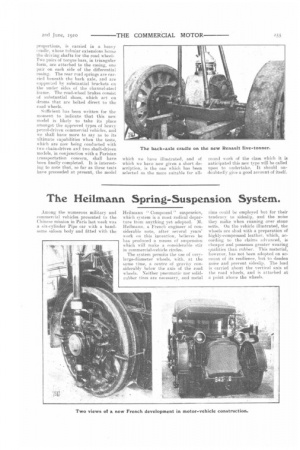A New Five-ton Renault Model.
Page 6

Page 7

If you've noticed an error in this article please click here to report it so we can fix it.
The fact that a manufacturer has achieved a world-wide reputation with a large range of pleasure-car chassis makes any announcement of interest in which it is stated that such a maker has decided to produce a heavy type of commercial-motor vehicle. It is not always the case that such a development of design is successful, and instances are not wanting if disastrous attempts that have been made to embody what is purely-pleasure-car practice into new and heavy models, which it is intended shall meet the utilitarian requirements of one or more classes of industrial-vehicle users.
Renault Fferes, Ltd., has a reputation for the production of high-class pleasure cars, ranging from the small runabout to the mighty racer, which has been excelled only in very few eases. The extensive employment of the Renault motorcab in London has familiarized many British users with the capabilities of this maker with regard to the smaller types of industrial machines. It is, therefore, with special interest that we are now enabled to give some particulars of a model, from the shops of this maker, which may be classified amongst the heaviest types of commercial-motor vehicles in common use.
The new five-ton, petrol-driven Renault lorry, so far as we are able to P5 s any comment upon it without the
crucial test of observation under working conditions, appears to be one which should still further enhance the reputation of a great maker. We reproduce several photographs, from an inspection of which an excellent idea of the sturdy and useful nature of the whole design may be obtained. Some indication of this company's intentions in this direction has, for some time, been evident from the fact that the Compagnie Generale des Omnibus de Paris, has recently been testing, amongst other models, a single-deck Renault motorbus.
So far as the general arrangement of the mechanism is concerned, it will be observed that the design is, on the whole, conventional, with the exception, perhaps, that, for such large models as this, the distinctive position of the Renault radiator has hitherto not found many advocates, although it is remarkable how the practice of placing this component behind the engine and next to the dashboard has commended itself to several motorcab manufacturers. The two excellent illustrations of the engine serve as a keynote to the clean style in which the whole design of this chassis has been conceived. The motor is a four-cylinder model with the cylinders east in pairs, and each has a bore of 110 mm. ; the piston stroke is 160 mm. As a type, this engine conforms very closely, in the arrangement and proportion of its parts, to those other Renault models whose silence and accessibility are charleteristics which have been so highly commended ill pleasure-car service. It is probable that the arrangement of the watercooling apparatus is the feature which will make the first appeal to the user of heavy petrol vehicles. The ample sizes of the pipes, and the easy arrangement of the thermo-syphon system, in conjunction with the huge radiator, calls for praise. The accessibility of the valves, of the magneto, and of the carburetter, and the compact arrangement of the leads to the ignition plugs, are all evident in the photographs of which we make use on this page. It is interesting to note that the lubricator pump, which is driven off the camshaft, in addition to delivering oil to the main bearings of the engine, also supplies lubrication to the gearbox and to the back axle.
An inverted cone clutch is employed, and the gearbox, which is of normal design, provides four speeds and a reverse. The final drive is by means of a propeller shaft to a live axle, which is the most-distinctive feature of this new model. The differential casing, which is of very-considerable proportions, is carried in a heavy cradle, whose tubular extensions house the driving shafts for the road whee]: Two pairs of torque bars, in triangular form, are attached to the casing, one pair on each side of the differential casing. The rear road springs are carried beneath the back axle, and are supported by substantial brackets on the under sides of the channel-steel frame. The road-wheel brakes consist of substantial shoes, which act on (trims that are bolted direct to the road wheels.
Sufficient has been written far the moment to indicate that this new model is likely to take its place amongst the approved types of heavy petrol-driven commercial' vehicles, and we shall have more to say as to its ultimate capabilities when the tests, which are now being conducted with two chain-driven and two shaft-driven models, in conjunction with a Parisian transportation concern, shall have been finally completed. It is interesting to note that, so far as these tests have proceeded at present, the model
which we have illustrated, and of which we have now given a short description, is the one which has been selected as the more suitable for all round work of the class which it is anticipated this new type will be called upon to undertake. It should undoubtedly give a good account of itself.
























